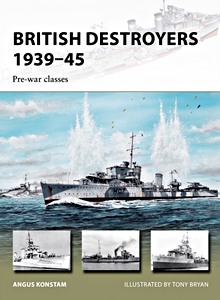British Destroyers - From Earliest Days to the Second World War
In the late 19th century the advent of the modern torpedo woke the Royal Navy to a potent threat to its domination, not seriously challenged since Trafalgar. For the first time a relatively cheap weapon had the potential to sink the largest, and costliest exponents of sea power. Not surprisingly, Britain's traditional rivals invested heavily in the new technology that promised to overthrow the naval status quo.
The Royal Navy was also quick to adopt the new weapon, but the British concentrated on developing counters to the essentially offensive tactics associated with torpedo-carrying small craft. From these efforts came 'torpedo catchers', torpedo-gunboats and eventually the torpedo-boat destroyer, a type so successful that it eclipsed and the usurped the torpedo-boat itself. With its title shortened to 'destroyer', the type evolved rapidly and was soon in service in many navies, but in none was the evolution as rapid or as radical as in the Royal Navy
This book is the first detailed study of their early days, combining technical history with an appreciation of the changing role of destroyers and the tactics of their deployment. Like all of Friedman's books, it reveals the rationale and not just the process of important technological developments.
Detalles del libro
| Autor: | Norman Friedman |
|---|---|
| Presentación: | 320 páginas, 29.5 x 25.5 x 2.6 cm, tapa dura |
| Ilustración: | 300 ilustraciones b/n |
| Editor: | Seaforth Publishing (GB, 2009) |
| ISBN: | 9781848320499 |

British Destroyers - From Earliest Days to the Second World War
Idioma: Inglés
Comprar en Amazon ESComprar en Amazon.com









